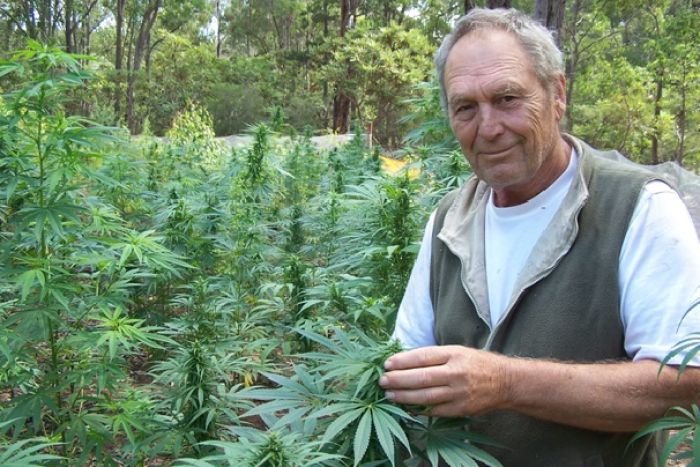Jacob Redmond
Well-Known Member
A newly-formed industry association will seek to promote the farming and processing of hemp products in Western Australia.
The Industrial Hemp Western Australia Association, known as iHempWA, held its first annual general meeting in Margaret River on October 4.
A committee of 12 was elected from 28 members.
Hemp is a strain of the cannabis plant that contains low levels of tetrahydrocannabinol (THC), the chemical associated with psychoactive properties in marijuana.
Nannup hemp grower Glenn Ossy-Orley is in his second growing season and was appointed chair of the association.
It is legal to grow hemp in Australia under a licence, but the product may not be used for consumption.
Mr Ossy-Orley said he was only growing about half a hectare of crop for seed stock cultivation.
He said he was hoping to build up seed stock to supply other farmers.
"At the moment there's a shortage of seed," Mr Ossy-Orley said.
"There's a shortage of the type that I grow, which is the plant that is high in the CBD [cannabidiol] oil rather than THC."
Mr Ossy-Orley said he and the association were seeking to grow the industry to capitalise on high demand for hemp products.
He said there was growing demand for the many manufacturing and industrial uses for the plant domestically and overseas.
"The oils can be turned into plastics," he said.
"It could be used in textiles [and] construction – we can't keep up for the demand for [hemp concrete]."
Hemp Crop Grows Well In WA
Mr Ossy-Orley said the crop grew well in Western Australia's south-west, but the plant required a lot of water.
He said the main reason there was a shortage of farmers opting to grow the crop was fear.
"A lot of people are scared," he said. "And when you try to explain to them that there's little THC, they are a little bit interested but they are still scared."
Mr Ossy-Orley said there was a need to reduce red tape and restrictions on growing hemp to ensure industry success.
He said it was an important environmentally sustainable commodity.
Australian hemp growers and a consumer body are currently lobbying the government to overturn the restrictions on hemp consumption.
Hemp supporters around Australia believe that more farmers should be growing the crop to take advantage of demand.
Education Is The Key
Industrial Hemp Western Australia Association secretary David Chick said the key to industry success was to break down the stigma associated with hemp.
Mr Chick said the association would dedicate itself to teaching the public about the industrial uses for the plant.
He said the industry needed support to supply growing markets.
"We need growers because of the demand," he said.
"We've got a lot of demand for building products, which is concrete made from the core of the stem."

News Moderator: Jacob Redmond 420 MAGAZINE ®
Full Article: New Industry Association Formed To Promote Hemp In Western Australia
Author: Bridget Fitzgerald
Contact: Contact Page
Photo Credit: David Chick
Website: ABC Australia
The Industrial Hemp Western Australia Association, known as iHempWA, held its first annual general meeting in Margaret River on October 4.
A committee of 12 was elected from 28 members.
Hemp is a strain of the cannabis plant that contains low levels of tetrahydrocannabinol (THC), the chemical associated with psychoactive properties in marijuana.
Nannup hemp grower Glenn Ossy-Orley is in his second growing season and was appointed chair of the association.
It is legal to grow hemp in Australia under a licence, but the product may not be used for consumption.
Mr Ossy-Orley said he was only growing about half a hectare of crop for seed stock cultivation.
He said he was hoping to build up seed stock to supply other farmers.
"At the moment there's a shortage of seed," Mr Ossy-Orley said.
"There's a shortage of the type that I grow, which is the plant that is high in the CBD [cannabidiol] oil rather than THC."
Mr Ossy-Orley said he and the association were seeking to grow the industry to capitalise on high demand for hemp products.
He said there was growing demand for the many manufacturing and industrial uses for the plant domestically and overseas.
"The oils can be turned into plastics," he said.
"It could be used in textiles [and] construction – we can't keep up for the demand for [hemp concrete]."
Hemp Crop Grows Well In WA
Mr Ossy-Orley said the crop grew well in Western Australia's south-west, but the plant required a lot of water.
He said the main reason there was a shortage of farmers opting to grow the crop was fear.
"A lot of people are scared," he said. "And when you try to explain to them that there's little THC, they are a little bit interested but they are still scared."
Mr Ossy-Orley said there was a need to reduce red tape and restrictions on growing hemp to ensure industry success.
He said it was an important environmentally sustainable commodity.
Australian hemp growers and a consumer body are currently lobbying the government to overturn the restrictions on hemp consumption.
Hemp supporters around Australia believe that more farmers should be growing the crop to take advantage of demand.
Education Is The Key
Industrial Hemp Western Australia Association secretary David Chick said the key to industry success was to break down the stigma associated with hemp.
Mr Chick said the association would dedicate itself to teaching the public about the industrial uses for the plant.
He said the industry needed support to supply growing markets.
"We need growers because of the demand," he said.
"We've got a lot of demand for building products, which is concrete made from the core of the stem."

News Moderator: Jacob Redmond 420 MAGAZINE ®
Full Article: New Industry Association Formed To Promote Hemp In Western Australia
Author: Bridget Fitzgerald
Contact: Contact Page
Photo Credit: David Chick
Website: ABC Australia


